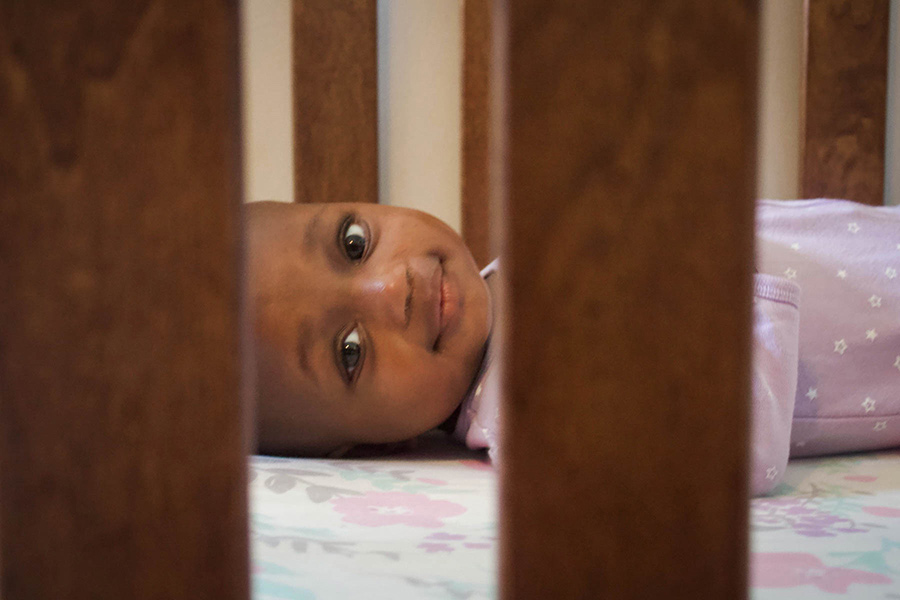Newborn Sleep Tips

Whether you are worried about how much sleep your newborn is getting or how little you are, sleep is easily one of the biggest challenges many new parents face. The good news is, as your baby gets older, they’ll be able to sleep longer. In the meantime, it’s helpful to know how many hours you can expect your baby to sleep and to go ahead and start a bedtime routine (your future self will thank you).
In this article:

How much your newborn will sleep in the first 3 months
According to the Centers for Disease Control and Prevention (CDC), newborns typically sleep around 14 to 17 hours per day in the first 3 months. If you’re as sleep-deprived as the average new parent, that might be hard to believe when your baby is only sleeping for 1 to 2 hours at a time. While that sleep pattern can be hard on you, it’s completely normal and healthy for your baby.
Myth Buster: If anyone has encouraged you to put cereal in the bottle to help your baby sleep longer, know that research shows it does not help baby to sleep longer and may actually be harmful.

What to expect at 3 to 4 months old
By the 3- to 4-month mark, the CDC recommends infants get 12 to 16 hours per day, including naps. That is similar to how much sleep your baby was getting in the first 3 months, but by now they’re probably starting to sleep for longer stretches at a time. The main reason your baby can sleep for longer is because their stomach has grown. Your baby’s bigger stomach can hold more food than before, helping them to stay fuller longer. You may read that and think you should aim to feed your baby as much as possible before bed, but that doesn’t work.
Feeding your baby more than they need or want won’t make them sleep any longer. Instead, overfeeding can make your baby feel uncomfortable and lead to bigger problems down the road, such as reflux.

Establishing a sleep routine
Babies are comforted by consistency, so starting a short and simple routine to help your baby know it’s time for bed can go a long way. The best bedtime routine is one that works for you and your baby, but here is a sample routine to give you an idea of what yours could look like:
- Feed
- Wash up (you can skip soap every other night to avoid drying out baby’s skin)
- Fresh diaper
- Cradle
- Lay down
Pro Tip: Lay your baby down to sleep when they are sleepy rather than when they are already asleep. This way, your baby learns to fall asleep on their own instead of relying on you to rock or soothe them before falling asleep. (Again, your future self will thank you.)

Practicing safe sleep
The most important thing to do when it comes to your baby’s sleep is to practice the ABCs of safe sleep:
- Put your baby to sleep alone.
Sharing a bed or napping on the couch puts your baby at risk for suffocation. -
Place you baby on their back.
Your baby's neck muscles aren't strong enough to prevent suffocation if they sleep on their stomach, so being flat on their back on a firm surface is the only safe way to sleep. -
Ensure your baby’s sleep space is clear.
Their crib mattress should be firm, covered in only a fitted sheet, and the crib should be empty. Blankets, toys, lovies, bumper pads and other items can all cause suffocation.
There is a lot of misinformation and survival (or survivorship) bias about safe sleep practices. For example, you may hear people say things like, “I put my baby to sleep on their stomachs, and they turned out fine,” or “I shared a bed with all 3 of my babies, and nothing bad happened.” While it’s wonderful that nothing bad happened to those babies as a result of their sleeping situations, the harsh reality is that SUID (Sudden Unexpected Infant Death) is the leading cause of death for children under the age of 1.
Pro Tip: As soon as your baby is starting to roll over, it’s time to drop the swaddle. Swaddling a baby once they’ve started rolling over keeps them from being able to roll back. It may startle you when it first happens, but it’s OK if they want to sleep on their stomachs (however, you should still continue to place them on their backs when they first go to sleep). If you’re worried about your baby getting cold without the swaddle, you can use a wearable blanket.
Co-sleeping vs. bed-sharing
The AAP recommends babies sleep in the same room as their caregiver for at least the first 6 months of life. This form of co-sleeping or room-sharing is not the same as bed-sharing (when the caregiver and baby sleep in the same bed or on the same couch). While sharing a bed may make nightime feedings easier, take it from a Chlidren’s PICU nurse who has seen far too many parents leave the hospital without their babies that “just this once” is not OK.
Whether you choose to share a room with your baby or put them to sleep in a separate room is up to you. The most important thing is that you—and anyone caring for your baby—follow the ABCs of safe sleep.



